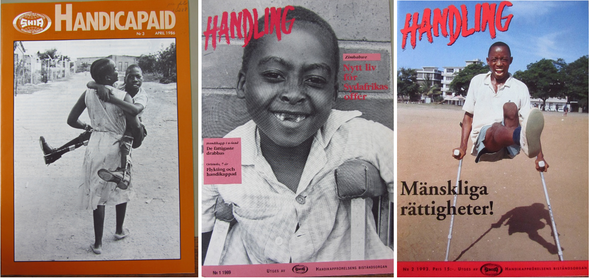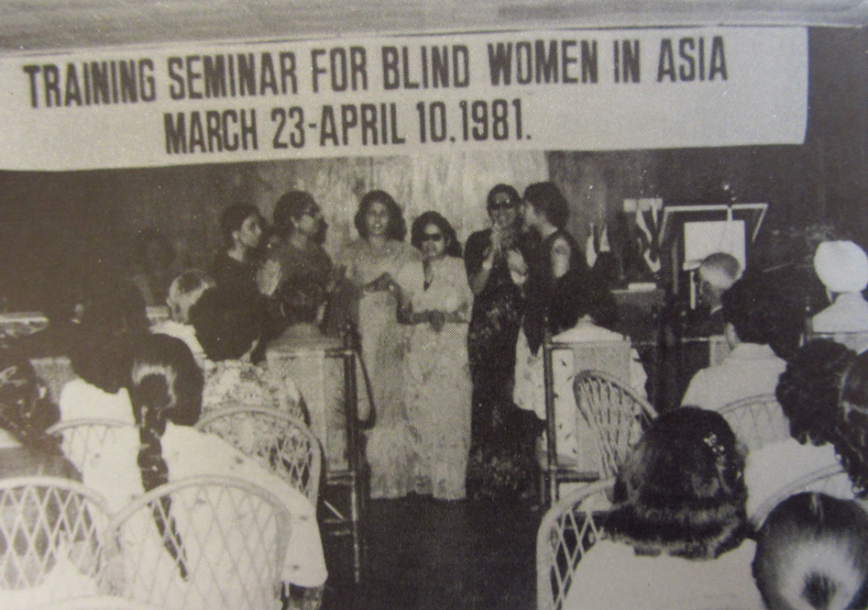Disability, development and the Nordics, 1960s-2000
Nordic disability organizations have been carrying out development projects in the Global South since the 1960s. Initially a preventive and rehabilitative approach was taken with, for example, a focus on schools for special education, vocational training and medical care. Although important, this type of aid became increasingly seen as paternalistic. The 1980s saw an increased focus on organization-building and grassroot initiatives including those to advance equal opportunities, participation in civil society and political decision-making. During this time, the Nordic countries became a leading region in promoting disability as an important global rights issue. The 1988 development aid program of the Nordic Council of Ministers specifically mentioned persons with disabilities, and in 1990s it became a central topic in Nordic development policy, something that has been built on since.

Nordic disability organizations have been carrying out development projects in the Global South since the 1960s. Initially they focused on humanitarian interventions, schools for special education and vocational training as well as medical care, thus taking a preventive and rehabilitative approach to disability. Similar projects were carried out by other countries like the United Kingdom and France, as well as by international organizations. Although this type of aid often functioned as an important substitute for state welfare, it was increasingly seen as paternalistic, tied to Western definitions and values of disability, and neglected disabled people’s equal rights and freedom of choice.
The global orientation of the United Nations International Year of Disabled Persons (IYDP) in 1981 provided an opportunity to re-evaluate the goals and strategies of aid projects. Building on a sense of international solidarity among people with disabilities, Nordic disability rights organizations embarked upon a ‘new’ type of disability development aid by formalizing their activities through new umbrella organizations. In 1981 Swedish disability organizations founded the Swedish Handicapped International Aid Agency (SHIA, today MyRight) as an independent non-governmental organization that coordinates projects with disability organizations in Africa, Asia and Latin America, and since the 1990s also Eastern Europe and the Balkan region. Also in 1981, the Atlas Alliance was established in Norway. Both associations continue to be financially supported by the respective national development agencies NORAD (national development agency in Norway) and SIDA (national development in Sweden). Disability development projects in Finland have been undertaken by the Finnish Disabled People’s International Development Association (FIDIDA, today Disability Partnership Finland) since 1989, and the Abilis Foundation since 1998. Denmark has no particular association for disability development projects, but a number of international projects are conducted by the national disability association (Danske Handicaporganisationer (DH)). Icelandic disability organizations have participated in joint Nordic projects and occasionally carried out smaller projects in selected partner countries.

Covers of Handicapaid/Handling, which were the membership magazine of the Swedish Handicapped International Aid Foundation (SHIA), in 1986, 1989 and 1993. SHIA is now called My Right, which is the Swedish disability rights movement’s umbrella organisation for international development work. Photos: Reproduced with kind permission from My Right.
A common feature of these initiatives that distinguishes them from development assistance projects funded by other countries has been their pronounced multilateral and horizontal approach that focused especially on supporting grassroots initiatives and organization-building to advance equal opportunities, participation in civil society and political decision-making, as well as education and employment in the regular labour market. Training seminars about rights issues, self-advocacy as well as public awareness campaigns also formed an important part of the work.
The Training Seminar for Blind Women in Asia, organized in Kuala Lumpur during the IYDP in 1981 by the Swedish and Malayan Blind Associations, provides a good illustration of this Nordic approach to disability development, bringing together 25 blind women from ten different Asian countries with the express aim of developing strategies to advance their self-representation and opportunities in society from a social and human rights perspective. Despite these highly ambitious goals, however, Nordic projects have also received criticism – for being too idealistic, for misjudging the local realities of people with disabilities, or for being ignorant of differing cultural and religious perceptions of disability.

The Training Seminar for Blind Women in Asia was a joint project by the Swedish and Malayan Blind Associations, the General Assemblies of the World Council of the Welfare of the Blind and the International Federation of the Blind and it took place in Kuala Lumpur in 1981. The photo is from the Swedish Federation of the Visually Handicapped (ed.) Training Seminar for Blind Women in Asia. Report, Enskede 1981, p. 8. Photo: Swedish National Archives/Author.
Nevertheless, the continued activism of people with disabilities and their social and political support at home has established the Nordic countries as a leading region in promoting disability as an important global rights issue. In 1988 the Nordic Council of Ministers adopted a program for Nordic cooperation in development aid that specifically mentioned persons with disabilities, and in 1991 Finnish participants at a Nordic development aid seminar demanded that disability should become a central topic in Nordic development policy. Yet another important step was taken at the Copenhagen Conference in 2000, as the Nordic Ministers for Development Cooperation agreed on a joint policy declaration and commitment to mainstream disability issues in development cooperation. Though the communiqués are a statement of intent rather than a call for action, today they represent a framework in which all Nordic countries except Iceland are acting.
Further reading:
- G. M. Cederstam, ed., Vägen till människovärde. Några drag ur nordisk handikapphistoria åren 1945-1985 [The road to human dignity. Some features from Nordic disability history in 1945-1985] (Vällingby: Nordiska nämnden för handikappfrågor, 1990).
- B. E. Eriksson and R. Törnqvist, eds., Likhet och särart. Handikapphistoria i Norden [Equality and difference. Disability history in the Nordic countries] (Nynäshamn: Handikapphistoriska föreningen, 1995).
- S. T. Egilson, B. Berg and R. Traustadottir, eds., Childhood and Disability in the Nordic Countries. Being, Becoming, Belonging (Basingstoke: Palgrave Macmillan, 2015).
Links:
- My Right (earlier called SHIA)
- A. P. Kroglund: Leaving No One Behind. A Nordic Movement for Change (Discussion Paper, 2018).